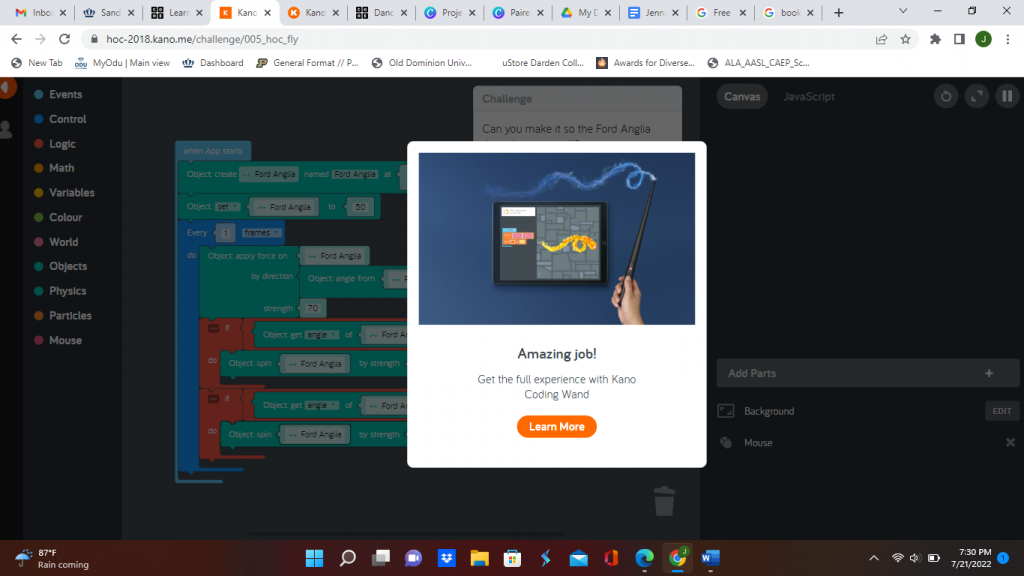This week’s articles about the librarians teaching coding and 3D printing were very inspiring. I loved what Nathan Sekinger said, “a library should be a place of discovery and exhibition, innovation and connection” (Filip, 2019). I can definitely see all of those qualities in my neighborhood library, the Bayside Special Services Library, but in my school library, not so much. That will be something to keep in mind when I become a school librarian myself. Though I’m not the most tech savvy, if I can do as Mary Moen said and try to “be comfortable with the discomfort of taking risks and letting go of control” (2016), then I can not only “support traditional literacies of reading and writing” (2016) but as an information specialist, “try new things and create student-centered learning activities” (2016) in collaboration with the classroom teachers.
Since we introduce coding to our students on the primary level where I work, I decided to try the Hour of Code modules. I tried two programs, Dance Party and Harry Potter. Dance Party was nice because it had short videos to explain the types of commands that would be used to code in the upcoming levels. The videos were very helpful and were hosted by experts in their field. For example, musician Aloe Black explained measures in music and then how to code movements to go along with the measures. In the game, you select a lead and some back-up dancers and then program them to dance using specific moves at various points within the song. You could also select the song and speed at which the dancers move and whether they move at random or by using the arrow keys. It was fun and pretty easy until the final level when it would not play back my dance creation and would default back to a few preprogrammed commands. I reentered my code selections and took a screenshot to show that I completed all 10 levels.

After that I tried the Harry Potter coding game because I am a huge Harry Potter fan. This game required a bit more reading because directions were explained with text that would pop up in boxes at the top of the page. Then a pulsing light, meant to mimic a magic wand, would direct you on how to complete the commands that were just explained. That made it fairly easy to follow; however, the game was very glitchy, and I frequently had to refresh the frozen screen which meant I would have to do the coding all over again. I was finally able to complete the first three activities, levitating a feather, summoning some Bertie Botts, and shooting fireworks from my wand, but the fourth activity, playing music for the Yule Ball, would not play what I coded, and instead of allowing me to control the flying car after completing the fifth module, I was prompted to learn more about the Kano Coding Wand.

Overall, the Harry Potter game was fun but the number of technical issues and reading would be too frustrating for my students and therefore would not be something I would recommend using on the primary level. The Dance Party game was pretty easy though, especially with the short tutorial videos, and would be one that my second graders would probably enjoy. It may rekindle some annoying dance crazes like flossing and dabbing, but the students would love it.
References
Filip. (2019, Feb. 28). Making a place for “3D’ in our school library. IMADE3D. https://www.imade3d.com/2019/02/making-a-place-for-3d-in-our-school-library/
Moen, M. (2016, Sept. 30). Computer coding and literacy: Librarians lead the connection. International Literacy Association. https://www.literacyworldwide.org/blog/literacy-now/2016/09/30/computer-coding-and-literacy-librarians-lead-the-connection
Thanks for sharing both of these coding activities. I love the Dance Party one, I am going to explore this on my own! I didn’t realize there were so many coding extensions.
This is very cool! I will be showing my girls both of the coding programs as one is a huge fan of music and dance, and my other is still obsessed with HP after all these years. Thank you for sharing and great work!
I did the 3D printing. I want to go back and play with the coding. I love Harry Potter also. It’s disappointing that there were so many problems with it.
I’m going to have to try Dance Party! Sounds awesome. I did HP too and had a lot of fun. I had to start over a couple of times to get the Yule Ball scene correct but I got there in the end. I didn’t have that with the Kono wand for the flying car. It was a much longer lesson and every time I thought I was done it had me do more but it worked for me.
The Harry Potter coding sounds fun! It’s sad that it was glitchy, though.
I live in Virginia Beach and need to check out the Bayside Special Services Library. I have heard wonderful things about it! It was interesting to see what coding looks like at a higher level. I chose to look at the younger grades since that’s what I teach, but those games look fun for the kids and provide more of a challenge! Thank you for sharing!
Nice post Jennifer! I need to try the Dance Party coding modules as it seems like a good place to start for beginners. Thanks for sharing.